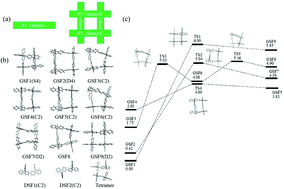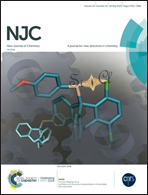A novel structure of grid spirofluorene: a new organic semiconductor with low reorganization energy†
Abstract
The lower charge mobility of organic semiconductors relative to that of inorganic semiconductors is a thorny problem that still has not been resolved. Here, a new type of arrangement of grid-shaped organic semiconductors with extremely low values of internal reorganization energies (IREs) for both hole (0.056 eV) and electron (0.078 eV) transfer processes has been designed and investigated by density functional theory (DFT) calculations. The structural, thermodynamic and electronic properties of grid spirofluorene (GSF) consisting of four spirobifluorenes have been discussed thoroughly. Our analyses of these unique grid structures indicate that they possess a stringent structure and very weak ring strain energy, and may be easily synthesized in the laboratory. Interestingly, GSF1, GSF2, and GSF9 possess both small hole and lower electron transfer reorganization energies (<0.1 eV), which may originate from their rigid molecular structures. The large π conjugated system in which all of the frontier molecular orbitals are homogeneously delocalized over the entire molecules is another important characteristic of these GSFs. This work reveals that the gridization method is a novel strategy for obtaining materials with low hole and electron transfer reorganization energies.



 Please wait while we load your content...
Please wait while we load your content...